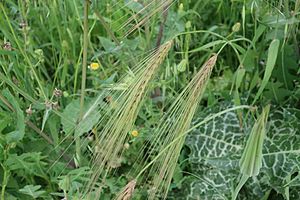Wild barley facts for kids
Quick facts for kids Wild barley |
|
|---|---|
 |
|
| Scientific classification | |
| Genus: |
Hordeum
|
| Species: |
spontaneum
|
| Synonyms | |
|
|
Hordeum spontaneum, commonly known as wild barley or spontaneous barley, is the wild plant that our common cereal barley (Hordeum vulgare) came from. It belongs to the family Poaceae, which includes many types of grasses. Scientists believe that people started growing wild barley to use as food a very long time ago, possibly in two different places. The first time was about 10,000 years ago in a region called the Fertile Crescent. Later, it was grown again thousands of kilometers further east.
Contents
What is Wild Barley Like?
Wild barley is a plant that grows every year. It looks a lot like the barley we grow on farms (Hordeum vulgare). However, wild barley has slightly thinner leaves, taller stems, and longer awns (bristle-like parts on the seed head). Its central seed stalk, called a rachis, breaks easily when the seeds are ripe. This helps the seeds spread naturally. Wild barley also has smaller grains that are covered in a hull, and they grow in two rows.
In contrast, the barley grown by farmers has a stronger rachis that doesn't break easily. Its seeds are usually arranged in two or six rows. In some parts of the world, like the east, barley is grown for people to eat, and they prefer grains without the hull. In other places, like the west, barley with the hull is grown more often. This type of barley is used to feed animals or to make malt for drinks.
Where Does Wild Barley Grow?
Wild barley naturally grows in North Africa, the Middle East, parts of India, and southwestern China. You can find it in many countries, including Libya, Egypt, Israel, Lebanon, Jordan, Syria, Turkey, Iran, Iraq, Afghanistan, and parts of China like Sichuan and Xizang.
This tough plant can live in many different places, from hot deserts to areas with a Mediterranean climate, and even in high mountains. It grows by itself in both farmed and unfarmed fields. Wild barley can handle tough conditions like very hot weather, dry spells, and salty soil. Different wild barley plants have adapted to the specific microclimates (small, local climates) where they grow. Because it's so tough, wild barley is a valuable resource. Scientists can use its genes to help create new types of farm barley that can also survive harsh conditions.
How Did Wild Barley Become Our Food?
The process of turning wild barley into a farmed crop probably began around 10,000 years ago. This happened in the Israel and Jordan area, which is part of the Fertile Crescent. Scientists have found old barley grains at many ancient sites in this region. The wild barley plants found here are genetically very similar to the barley we grow today.
At first, some scientists thought barley was farmed in many different places, like Ethiopia or the Mediterranean region. However, new research using special technology suggests that barley was first farmed in at least two main events. One event happened in the Fertile Crescent. The other happened about 1,500 to 3,000 kilometers (930 to 1,860 miles) further east. The barley from the Fertile Crescent led to the types of barley grown in Europe and America. The barley from the eastern event led to the many different kinds of barley grown in central Asia and the Far East.
In ancient Palestine, farmers would get the ground ready for barley in December. They would plant the barley seeds in January and then harvest the crop in April.
Gallery





